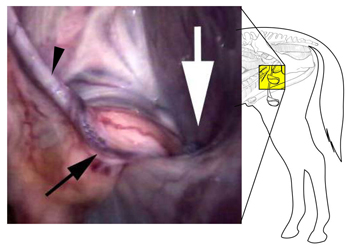| Home Medical Index | First Posted Dec 29, 2009 Jan 21, 2020 | |
Cryptorchidism in Horses Undescended Testicle in the Horse (Cryptochidism)
The following article is a direct quote from the following link: Cryptorchidism in Horses. There was no visible copyright statement on the site. "What is cryptorchidism in a horse? Category: Equine Cryptorchidism is a common problem in male horses. Since cryptorchid horses have a high incidence of testicular cancer, surgical removal of the testes is usually the recommended treatment. Failure of one or both testicles to move into the scrotum normally. Cryptorchidism is a common problem in male horses. Since cryptorchid horses have a high incidence of testicular cancer, surgical removal of the testes is usually the recommended treatment. Failure of one or both testicles to move into the scrotum normally. During fetal development, the testicles are located in the fetal horse's abdomen. Usually by birth, the testicles have descended into the scrotum, and can be palpated in the scrotum of colts by 30 days of age. However, in some normal horses the process of testicular descent through the inguinal ring into the scrotum may take up to four years. Testicles located in the abdomen rarely descend. Cryptorchidism is the condition in which either or both of the testicles fail to descend into the scrotum. This is a common problem in horses and is genetic; it is a dominant trait that is passed on to the affected horse's offspring. Most cryptorchid horses have one undescended testicle, with the left testicle being most frequently affected. These horses are fertile, but may have low sperm counts. The relatively few cryptorchid horses with both testes undescended will usually be sterile. The higher temperatures within the abdomen destroy the sperm-forming tissue of the undescended testicles. Diagnosis of cryptorchidism is based on physical examination, including rectal examination, and blood (plasma) hormone tests. Since descent of the testicles is thought to be under the influence of hormones, treatment with a series of hormone injections is occasionally attempted in selected cases. However, there is inadequate data at this time to determine the likelihood of successful treatment. Furthermore, because cryptorchidism is thought to be an inherited problem, the recommended treatment is usually surgical removal of both testicles rather than attempting to relocate the undescended testicle. This treatment is also recommended for patients with only one testicle retained. It is considered unethical to remove the descended testicle without also removing the retained testicle at the same time. If both of your horse's testicles are undescended at three years of age, breeding is probably a moot question, as he is very likely sterile. Additionally, stallions with retained testes have a high incidence of testicular cancer. Please consult with your veterinarian, who can advise you as to the best way to proceed in this case." For More Information: Cryptorchidism in the ColtCryptorchidism (Undescended Testicles) in the Horse "The Cryptorchid Horse" by Dr Peter Gillespie. BVSc MACVS. |